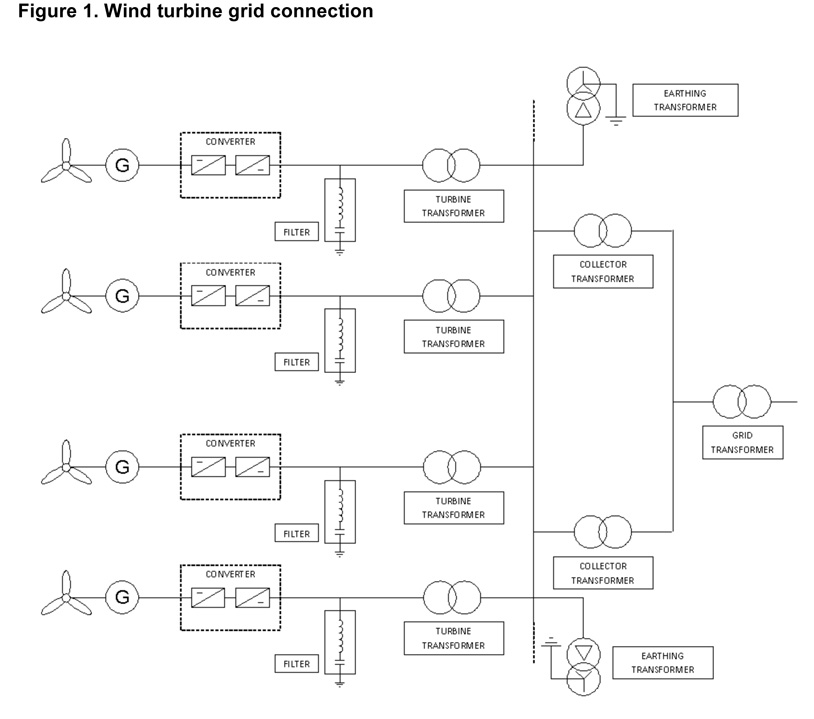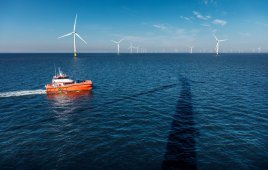By Mark Lashbrook | Senior Applications Engineer
M&I Materials
Wind turbine transformers pose a unique set of challenges to the designers and engineers who specify them. The transformers are typically of distribution size and rating, but do a job that differs from a standard distribution unit.
The schematic Wind turbine grid connection shows a typical setup for a wind farm, from the turbine to the grid connection. The variability of wind is an important factor here because it causes wide load fluctuations and often several in one day. This places unique demands when compared to a distribution transformer, which may only see one or two load cycles.

The schematic shows that a wind farms require several different types of transformers. (Source: “Transformers for wind turbine generators,” S. Sarkar, Virginia Transformer Corp, 2013)
The converter between generator and transformer is also an important feature. The converter is in place to take the variable frequency and voltage output from the generator, and convert it to a stable frequency and voltage output that’s suitable for grid connection. The downside of using a converter, however, is that it imposes harmonics on the transformer, which must be accounted for in design. The magnitude and composition of the harmonic load may also vary.
Along with an inconsistent load, a transformer must deal with potential faults. Because it’s connected in an array with other units, there’s a reasonable possibility of faults occurring somewhere on the array that must continually be managed by the transformer.
As power levels increase in wind turbines, it’s also necessary to increase the operating voltage of transformers. Consequently, manufacturers are now specifying more liquid-filled transformers in place of the cast-resin versions commonly used in lower power turbines. Liquid-filled transformers have shown higher reliability and offer proven longevity in mechanically stressful environments.
Designers face a tough decision when selecting a type of transformer fluid to use from the many options available. Two key considerations that should impact this choice: fire safety and environmental impact.
Fire-risk assessment
When a transformer is located within a turbine, fire safety must be addressed to reduce the risk of costly equipment damage and injury to site personnel. There’s always a risk to workers during construction or turbine maintenance, so minimizing hazards must be a priority.
According to IEC 61039 (Classification of Insulating Liquids 2008), fluid dielectrics can be classified based on their fire point. The following table lists the fire point of common transformer fluids and the resulting IEC classification.
 The letter in the third column denotes the fire point. For instance, ‘O’ class is below 300°C and ‘K’ class is above 300°C. The number indicates the calorific value of the fluid, whereby ‘1’ represents a value above 42MJ/kg, ‘2’ indicates between 32MJ/kg and 42MJ/kg, and ‘3’ means less than 32MJ/kg. The highest rating of K3 is awarded to the highest fire-safe fluids.
The letter in the third column denotes the fire point. For instance, ‘O’ class is below 300°C and ‘K’ class is above 300°C. The number indicates the calorific value of the fluid, whereby ‘1’ represents a value above 42MJ/kg, ‘2’ indicates between 32MJ/kg and 42MJ/kg, and ‘3’ means less than 32MJ/kg. The highest rating of K3 is awarded to the highest fire-safe fluids.
By using K-Class fluid-filled transformers, the fire hazard is significantly reduced. In fact, in the 35-plus year history of K-Class fluids there has never been a reported fire incident. Mineral oil doesn’t satisfy the criteria of Class K less-flammable fluid. It’s deemed high risk and unsuitable for transformers installed within turbines.
Turbine operators are finding an alternative and wider use for ester-based fluids because of their fire-resistant properties. These fluids provide a combination of anti-wear qualities and environmental protection properties that are absent in mineral oil.
Environmental considerations
In addition to fire safety, environmental considerations present an important safety issue and should be factored in when choosing a transformer fluid. Any leakage or spillage of fluid can have a direct and sometimes devastating impact on the local environment.
Accidental or negligent misuse of these materials can also lead to legal consequences. Users should ensure related protocols are followed and that state and government legislation is understood before project installations commence.
With transformers, the main component that can damage the environment is the fluid contained in the tank. Mineral oil has traditionally been used, but the risks of use have proven high in wind turbines. Should the oil spill after an accident or a fire, extensive damage can result, including the pollution of drinking water or damage to the sea in offshore wind farms. Clean-up costs are also steep and containment is often required even for transformers with relatively small volumes of mineral oil.
When deciding on a transformer fluid, it’s important to consider how long the material persists before it’s degraded. The main internationally recognized biodegradation test is the Organisation for Economic Co-operation and Development (OECD) 301. It takes the test substance, mixes it with an activated sludge (usually from a wastewater plant), and then monitors how long it takes for the substance to biodegrade.
For a substance to be readily biodegradable under the OECD guideline, it must reach 60% degradation within 10 days of reaching 10%. This “10-day window” criterion means tested material must reach 10% carbon dioxide evolution within that timeframe. Because this test regime is extremely stringent, it’s expected that any material that achieves “readily biodegradable” status will rapidly degrade if released into the environment. It’s worth noting that some materials may be termed inherently biodegradable, but this is not equivalent to “readily biodegradable” just because these fluids degrade slowly.
The graph Comparative biodegradation rates shows those for common transformer fluids. The chart indicates that ester-based fluids easily meet the readily biodegradable criteria. The fact ester fluids degrade rapidly in the environment, however, doesn’t mean they will degrade quickly in the transformer. The processes that lead to biodegradation are very different to those that lead to fluid ageing in operation.
Biodegradation requires the presence of microbes that break fluids down and a suitable environment for them to reside. Usually this means the presence of water and appropriate temperatures. In a transformer system, the environment is far too hot and dry to sustain microbes and they would die off rather quickly, so the fluid could not biodegrade under normal operation.
Safer options
In terms of fire safety and biodegradability, ester-based fluids are a preferred choice for many wind-turbine operators. The fluids come in two types: synthetic and natural. When evaluating which ester oil to choose, the main difference is in their oxidation stability. Synthetic esters are extremely stable and suitable for breathing transformers that let the fluid contact the air. Natural esters are less oxidation stable and are only recommended for sealed systems.
For offshore turbines, or those found in remote locations, a synthetic ester is often the preferred choice. Even in a sealed transformer, a synthetic ester provides a robust solution and won’t degrade if the seal is compromised.
When designing and specifying transformers for wind turbines, an increase in onerous power demands is leading to the use of liquid-filled units, rather than the cast-resin designs that were widely used in the past. The selection of the correct liquid for a transformer is key to ensuring that a turbine is safe, reliable, and imposes minimal risk or impact on the environment should fluid leakage ever occur.
For a digital copy of the entire June issue of Windpower Engineering & Development, click here.
Filed Under: O&M, Safety, Transformers




